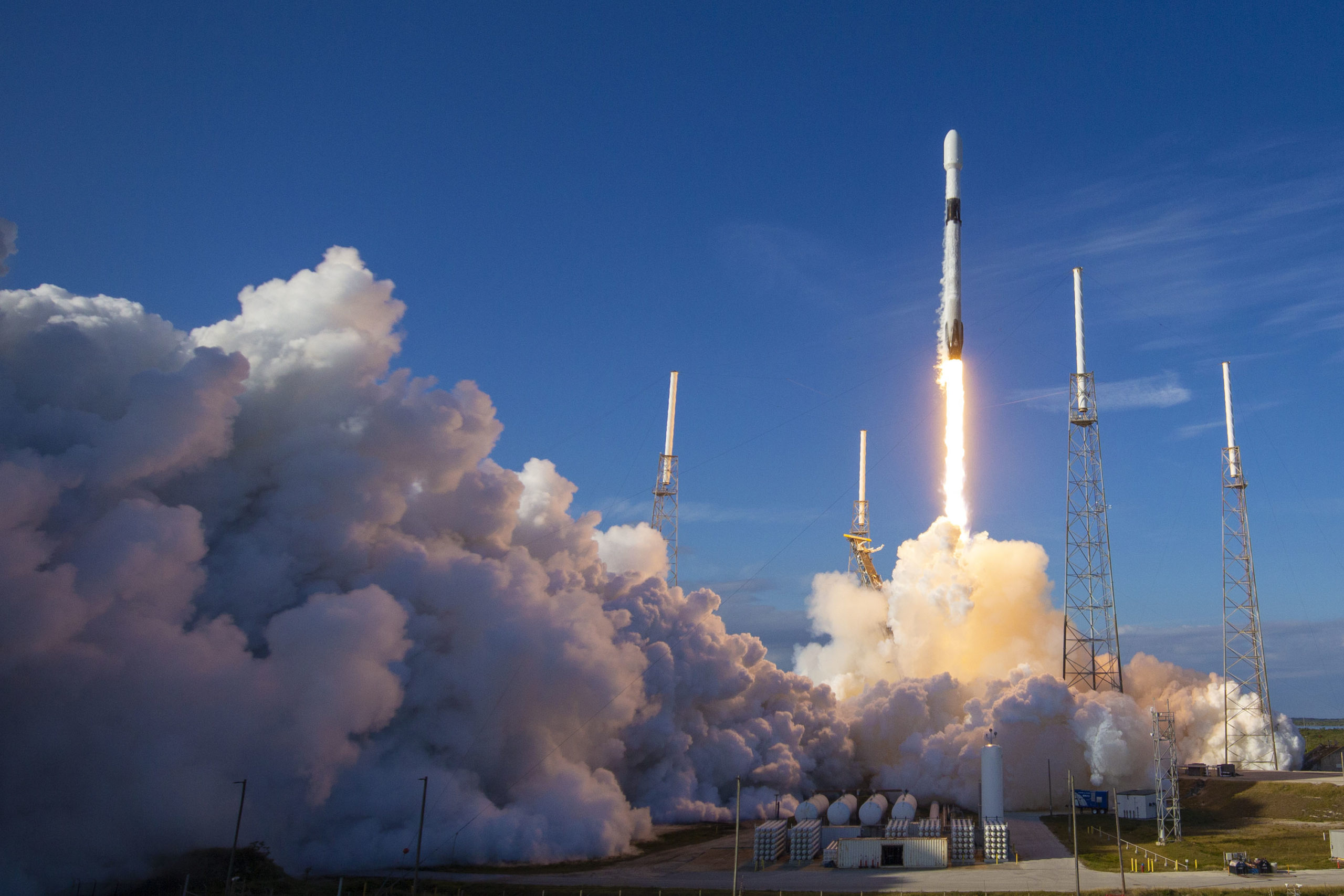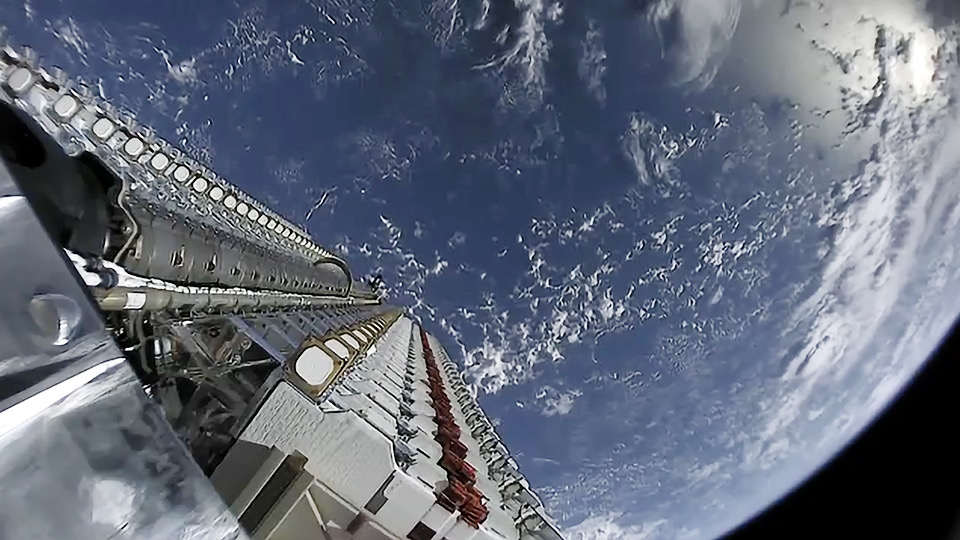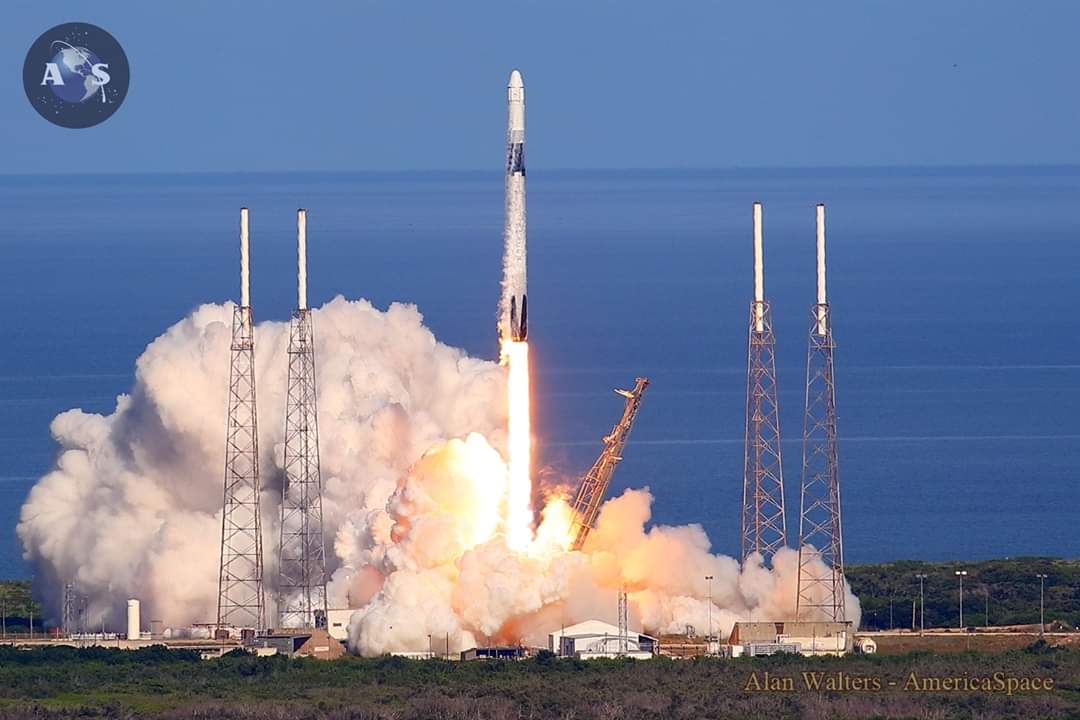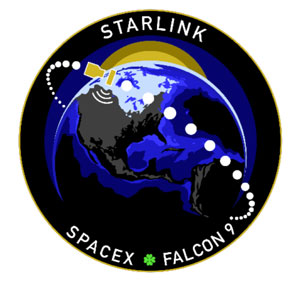
With three launches already under its belt from January, SpaceX has had no time for “rookie” Falcon 9 cores so far this year. The organization successfully launched a pair of four-times-used boosters last month to deliver a batch of Starlink low-orbiting internet communications satellites aloft and complete a spectacular In-Flight Abort Test of its Crew Dragon spacecraft. Then, another Falcon 9 core on its third mission was utilized to heave yet another Starlink load into space at month’s end.
This dramatic tempo will continue at 10:25 a.m. EST Sunday, 16 February, when the B1056 core—a veteran of three previous launches and only the fourth Falcon 9 in history to log a fourth mission—rises from Space Launch Complex (SLC)-40 at Cape Canaveral Air Force Station, Fla., to continue SpaceX CEO Elon Musk’s pledge to put thousands of Starlinks into orbit by the mid-2020s. A customary Static Fire Test of the nine Merlin 1D+ first-stage engines took place Friday.

B1056 previously delivered two consecutive Dragon cargo missions, CRS-17 last May and CRS-18 last July, towards the International Space Station (ISS), the first of which returned to a smooth oceanic touchdown on the Autonomous Spaceport Drone Ship (ASDS) “Of Course I Still Love You”, whilst the other alighted on solid ground at Landing Zone (LZ)-1 at the Cape. In total, these two missions—conducted under the Commercial Resupply Services (CRS) contract between SpaceX and NASA—trucked more than 10,560 pounds (4,800 kg) of payloads, equipment and supplies to the Expedition 59 and 60 crews. More recently, in December 2019, B1056 staged its maiden foray towards geostationary transfer orbit, when it lofted the heavyweight JCSAT-18/Kacific-1 communications satellite to provide mobile telephone, data and broadband internet services to 600 million people across 25 nations across Southeast Asia and the Pacific Islands.
And it is the shortness of the gap between the JCSAT-18/Kacific-1 launch and Sunday’s planned flight of the next Starlink batch that is expected to see B1056 set a new record for the narrowest interval between two missions by the same Falcon 9 core. If it launches on time Sunday, B1056 will log just 62 days since its last mission, easily eclipsing the 72 days set by the B1045 core between its two flights in April and June 2018.

And with an expected touchdown of B1056 on the deck of the Autonomous Spaceport Drone Ship (ASDS), “Of Course I Still Love You”, Sunday’s mission should mark the 50th recovery of Falcon hardware on either oceanic vessels or ground pads since December 2015.
If you happen to think that Sunday’s launch has a touch of “Groundhog Day” about it, you might not be far wrong, for this will be the fourth dedicated launch of Starlink satellites in less than three months, with batches of 60 having been lofted last November and twice in January 2020, together with “test satellites” which flew in February 2018 and May 2019. The $10 billion Starlink program, unveiled by SpaceX CEO Elon Musk in Seattle, Wash., in January 2015, has been described as a means of revolutionizing low-cost broadband provision. He identified it as a means of opening the way for competitively-priced services for urban regions and rural and underserved areas of the United States. Under the announced plan, an eventual constellation of 12,000 satellites could handle up to half of all backhaul communications traffic and a tenth of all local internet traffic in high-population-density cities by the mid-2020s.

Late in 2016, SpaceX described the concept as “non-geostationary” and revealed Starlink’s initial coverage would span the Ku-band and Ka-band regions, between 12-18 GHz and 26.5-40 GHz, respectively. By the late spring of the following year, plans were laid for a second orbital “shell” of satellites to utilize the V-band at 40-75 GHz, which is not routinely used for commercial communications purposes. Previously, the V-band has seen service for millimeter-wave radar research and scientific applications, but it reportedly also has promise for high-capacity terrestrial millimeter-wave communications networks.
SpaceX’s original intent was for 4,425 Ku-/Ka-band Starlinks to reside at an altitude of 710 miles (1,150 km) and 7,518 V-band birds to sit at 210 miles (340 km), producing a total population of these small satellites by the mid-2020s. However, in November 2018 SpaceX received licensing from the Federal Communications Commission (FCC) to operate a third of the Ku-/Ka-band complement—some 1,584 satellites—at just 340 miles (550 km), much lower than initially planned.

This will produce a relatively short operational lifetime of around five years, before they are maneuvered into a disposal orbit for controlled re-entry. SpaceX has explained that all satellite components are “100-percent demisable” and exceed “all current safety standards”, but the sheer volume of Starlinks to be launched in a relatively short period has aroused lingering controversy, both in terms of the work of astronomers and adding to ongoing debate about the effect of space debris.
Two Starlink test satellites, Tintin-A and Tintin-B, were launched in February 2018 and successfully validated the phased-array broadband antenna from an orbital perch 320 miles (515 km) above Earth. Then, last May, the first 60 “production-design” Starlink satellites were launched atop B1049. Although three of the satellites failed shortly after reaching orbit, the remainder are still healthy. More recently, in November 2019 and on two occasions in January of this year, a further three batches of 60 Starlinks apiece were boosted to space on three veteran Falcon 9 rockets.
SpaceX President Gwynne Shotwell has already confirmed plans to launch further 60-strong sets of Starlinks approximately every two weeks throughout 2020, raising the likelihood that many hundreds of these small satellites will be in orbit by next New Year’s Eve. And that pledge looks set to be met not only with words, but also with the roar of rocket exhaust, too, for Saturday’s launch will come a little more than two weeks since the most recent Starlink flight.
Assuming an ambitious 24 Starlink launches in 2020, it is also envisaged that SpaceX will stage more than a dozen missions for other customers. The next of those “other” customers looks set to be the next Dragon cargo mission (CRS-20) to the International Space Station (ISS) in the first week of March. Others include the first manned Crew Dragon mission with NASA astronauts Doug Hurley and Bob Behnken, the first cargo Dragons under the second-round Commercial Resupply Services (CRS2) contract with NASA and three Global Positioning System (GPS) Block III satellites.
.
.
FOLLOW AmericaSpace on Facebook and Twitter!
.
.




